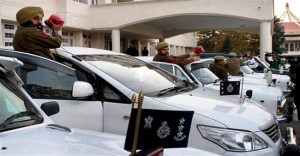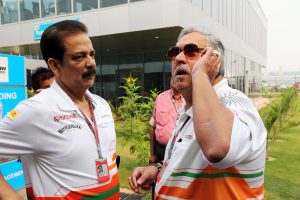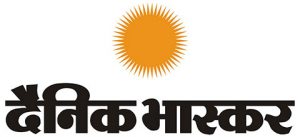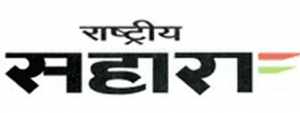
21-04-2017 (Important News Clippings)
To Download Click Here
Bye red beacon
Overthrow the many feudal privileges that Indian public servants enjoy

The reform follows from a Supreme Court ruling of 2013, where in response to a petition on misuse of the red beacon it was noted starkly that this was “reflective of the mentality of those who served British Government and treated the natives as slaves.” Feeding the Raj mentality, abuse of beacons makes the roads less convenient and more dangerous for the common citizen.
Of course this reform only marks a good beginning, because Indian public servants continue to enjoy so many other viceregal perks of power, such as grandiose Lutyens bungalows in the heart of the crowded capital of a crowded country where more than 40% households have only one room or less. What needs to be done, as Union minister Nitin Gadkari has suggested, is accommodate ministers and other lawmakers in multi-storey apartments. Even if some of these were to be as sprawling as 6,000 to 8,000 sq ft as Gadkari has proposed, the number of government high-rise apartments that could be built in place of say every 30,000 sq ft bungalow would free up lots of prime real estate – which would power a commercial boom in Delhi as well as state capitals.
Up and down the sarkari pecking order a message needs to go out loud: You are not a superior being. Stand in queues, carry your own baggage, don’t throw tantrums at toll plazas or manhandle airline workers, don’t lord it over the people you are paid to serve. Empower the common citizen not yourselves, because that is your job.
अच्छी राजनीति व अच्छा अर्थशास्त्र है कर्ज माफी

Date:21-04-17
आतंक के खिलाफ वैश्विक चौकसी बढ़ाने की जरूरत
माल्या व सुब्रत रॉय के खिलाफ कदमों का राजनीतिक असर

Date:21-04-17
एफआरबीएम रिपोर्ट पर डालें एक नजर
मौजूदा एफआरबीएम कानून दो परिचालन लक्ष्यों राजकोषीय घाटे और राजस्व घाटे पर पूरा ध्यान केंद्रित करता है। इस संबंध में विस्तार से जानकारी दे रहे हैं रथिन रॉय
लाल बत्ती की विदाई
केंद्र सरकार के इस फैसले की मुक्त कंठ से सराहना होनी चाहिए कि आगामी एक मई से विशिष्ट-अतिविशिष्ट व्यक्तियों की कारों में लाल बत्ती का इस्तेमाल नहीं होगा। यह फैसला इसलिए और स्वागतयोग्य है कि किसी को भी लाल बत्ती का इस्तेमाल करने की रियायत नहीं दी गई। चूंकि फैसले के सार्वजनिक होते ही अनेक केंद्रीय मंत्रियों के साथ कई राज्यों के मुख्यमंत्रियों ने भी अपनी कारों से लाल बत्ती हटवा दी इसलिए यह स्पष्ट ही है कि अधिकारी शायद ही एक मई का इंतजार करें। इस फैसले को एक मई अर्थात श्रमिक दिवस से लागू करने का फैसला यही बता रहा है कि मोदी सरकार मेहनतकश लोगों को एक खास संदेश देना चाहती है। लाल बत्ती महज एक अतिरिक्त सुविधा भर नहीं, बल्कि एक ऐसी संस्कृति का प्रतीक बन गई थी जिसका लोकतंत्र में कोई स्थान नहीं होना चाहिए था। आखिर इसका क्या औचित्य कि महत्वपूर्ण पदों पर बैठे लोग लाल बत्ती के जरिये विशिष्ट दिखने का काम भी करें। आम तौर पर लाल बत्ती वाहन से लैस व्यक्ति राजा और प्रजा वाला माहौल निर्मित करते हुए जनता को यही संदेश देते थे कि वे उनसे अलग और विशिष्ट हैं। यह आश्चर्यजनक है कि ऐसी सामंती मानसिकता का प्रतिनिधित्व करने वाली लाल बत्ती से मुक्ति पाने में इतना समय लग गया। नि:संदेह यह साधारण सी बात समझने में इतनी देर नहीं लगनी चाहिए थी कि चंद लोगों की ओर से विशिष्ट दिखने वाला कोई आचरण लोकतंत्र की मूल भावना के खिलाफ है।
हालांकि लाल बत्ती के खिलाफ लंबे समय से आवाजें उठ रही थीं और हाल में पंजाब और उत्तर प्रदेश के मुख्यमंत्रियों ने उसका इस्तेमाल करना बंद भी कर दिया था, लेकिन उनकी पहल का प्रभाव सीमित ही था। लाल बत्ती संस्कृति को खत्म करने के लिए वैसे ही किसी फैसले की जरूरत थी जैसा गत दिवस केंद्रीय कैबिनेट ने लिया। अच्छा यह होगा कि केंद्र सरकार केवल यहीं तक सीमित न रहे। उसे उन अन्य प्रतीकों और परंपराओं की पहचान कर उन्हें खत्म करने की जरूरत है जो वीआइपी संस्कृति का पोषण करते हैं। इस पर विचार होना चाहिए कि हवाई अड्डों पर कुछ खास लोगों को अतिरिक्त सुविधा क्यों दी जाती है? आखिर टोल नाकों पर केवल आम लोगों को ही पैसा क्यों देना चाहिए? इसी तरह क्या कारण है कि ढेर के ढेर कथित विशिष्ट लोगों को बिना जरूरत सरकारी सुरक्षा क्यों हासिल है? यह किसी से छिपा नहीं कि तमाम लोग महज विशिष्ट दिखने के लिए सरकारी सुरक्षा से लैस रहते हैं। वीआइपी संस्कृति को पुष्ट करने वाले प्रतीकों एवं परंपराओं और सुविधाओं तथा रियायतों को खत्म करने के साथ ही यह भी कोशिश होनी चाहिए कि महत्वपूर्ण पदों पर बैठे लोग वास्तव में लोक सेवकों वाली मानसिकता से लैस हों। आज स्थिति यह है कि वे कहलाते तो लोक सेवक हैं, लेकिन उनका आचार-व्यवहार इसके उलट दिखता है। यह सही समय है जब शासन और प्रशासन के तौर-तरीकों में व्यापक सुधार के लिए नए सिरे से कोशिश हो। बेहतर होगा कि द्वितीय प्रशासनिक सुधार आयोग की रपट की सुधि ली जाए। जब शासन-प्रशासन लोकतांत्रिक मूल्यों से लैस होगा तभी समाज सच्चे अर्थों में देश लोक का तंत्र बनेगा।
Date:21-04-17
और मजबूत हो आधार की बुनियाद
पहला मसला तो आधार को व्यापक पहचान के तौर पर उपयोग करने से जुड़ा है जबकि यह अभी भी अपुष्ट डाटाबेस है। वर्ष 2016 तक 100 करोड़ प्रविष्टियां बहुत कम या बिना सत्यापन के ही दर्ज की गईं। दिल्ली के पालिका बाजार में महज 40 रुपये में मिलने वाली आधार पहचान का हवाई अड्डों पर प्रवेश से लेकर जन-धन योजना बैंक खाते में केवाइसी के तौर पर इस्तेमाल किया जा सकता है। फर्जी आधार संख्या का बेलगाम मसला वास्तविक है और ऐसी कोई पड़ताल नहीं हुई जो यह दर्शाए कि भारतीय विशेष पहचान प्राधिकरण यानी यूआइडीएआइ ने कानून बनने से पहले की प्रविष्टियों को धारा 3(3) के अनुरूप जांचने के लिए कुछ कदम उठाए हैं या नहीं? परिणामस्वरूप आधार अभी भी अपुष्ट डाटाबेस ही बना हुआ है जिसमें दर्ज करोड़ों प्रविष्टियों में यह स्पष्ट नहीं है कि बायोमीटिक के समक्ष दर्ज नाम सही हैं या नहीं? डाटाबेस का खेल एकदम सीधा है वहां मैदान वैसा ही नजर आता है जैसे आप आंकड़े उपलब्ध कराते हैं। हालांकि धारा 3(3) और 4(3) से यही धारणा बनती है कि यूआइडीएआइ आधार से जुड़ी सभी सूचनाओं की प्रामाणिकता की गारंटी लेता है। इसी वजह से अब सभी सरकारी विभागों में पहचान के तौर पर आधार मांगा जाता है, मगर वे इस बात से या तो वाकिफ नहीं या फिर उन्हें इससे कोई फर्क नहीं पड़ता कि आधार से जुड़े आंकड़ों में काफी घालमेल है। कानून और सूचना प्रौद्योगिकी मंत्री संसद को आश्वस्त कर चुके हैं कि 2010 से 2016 के बीच इकट्ठा आंकड़ों की प्रामाणिकता को लेकर सरकार पूरी तरह निश्चिंत है। उन्होंने सदन को आश्वासन दिया कि यूआइडीएआइ द्वारा तैयार किया गया तंत्र पूरी तरह सुरक्षित और मजबूत है। हालांकि आधार से जुड़े तमाम फर्जी मामले भी देखने को मिले हैं। इसमें ताजा मामला तो उस पाकिस्तानी जासूस का भी है जिसने फर्जी नाम से आधार हासिल किया था। अगर उसके जरिये अगर आतंकी हमला होता तो क्या आधार को जिम्मेदार माना जाता?
फर्जीवाड़े की आशंकाओं को दूर करने के लिए यूआइडीएआई को तत्काल ही अपने डाटाबेस का ऑडिट, छंटाई और सत्यापन कराना चाहिए। राष्ट्र हित में इसकी अनदेखी भारी पड़ेगी। आधार को लेकर दूसरा मसला बेहतर सब्सिडी वितरण में उसे अनिवार्य बनाए जाने की बहस से जुड़ा है। यह व्यर्थ की बहस है। असल मुद्दा समावेशन और गैर-समावेशन का है। आधार को अवश्य ही सब्सिडी वितरण का माध्यम बनाया जाना चाहिए, क्योंकि सब्सिडी में घालमेल होने से गरीबों और जरूरतमंदों को ही नुकसान पहुंचता है। आधार को तभी अनिवार्य बनाया जाना चाहिए जब यह सुनिश्चित हो जाए कि इसका खामियाजा गरीब और जरूरतमंदों को नहीं भुगतना होगा। आधार की अनिवार्यता पर बनी दुविधा के लिए भी यूआइडीएआइ का ही एक अस्पष्ट नियम जिम्मेदार है। यह यूआइडीएआइ की लापरवाही का ही नतीजा है। उसे चाहिए कि वह राष्ट्रीय पहचान के मसले पर संसद की स्थाई समिति के जरिये सख्त निगरानी के हरसंभव उपाय करे। एक अन्य मसला डाटा सुरक्षा यानी निजता-गोपनीयता से जुड़ा है। जैसे-जैसे आधार और उसका नए-नए क्षेत्रों में विस्तार हो रहा है वैसे-वैसे उसके दुरुपयोग की आशंकाएं भी बढ़ रही हैं। डर है कि कहीं खुफिया तौर पर निगरानी के लिए तो डाटा का इस्तेमाल नहीं होगा। कुछ चिंताएं वाजिब हैं, लेकिन उनमें से अधिकांश समझ और सूचनाओं के अलावा पारदर्शिता के अभाव में ही पैदा हुई हैं। अगर सरकार ऐसे दुरुपयोग को रोकने के लिए उचित सुरक्षा इंतजाम करती है तो ये डर भी गायब हो जाएंगे। यह मसला नागरिकों से जुड़ी निजी संवेदनशील जानकारियां इकट्ठा करने, सहेजने और मुहैया कराने वालों की पारस्परिक जवाबदेही की कमी से जुड़ा है। इन जानकारियों के डाटाबेस की सुरक्षा को लेकर यूआइडीएआइ की कोई जवाबदेही नहीं तय की गई है। अगर इसकी प्रविष्टियां गैर-सत्यात, फर्जी और खामियों से भरी हैं तो ऐसे डाटाबेस को कैसे मानक बनाया जा सकता है? इसका जिम्मेदार कौन है?
निजता का मसला व्यापक और ज्यादा बुनियादी है। यह सरकार और सभी एजेंसियों की भूमिका और उत्तरदायित्व को लेकर वाजिब सवाल उठाता है और वह भी ऐसे दौर में जब हमारे जीवन में डिजिटल पैठ लगातार बढ़ रही है। वित्त मंत्री ने आधार विधेयक पर चर्चा के दौरान कहा था कि निजता मूल अधिकारों में आती है। उनकी यह बात मेरे रुख को ही दर्शाती है। आधार और सूचना प्रौद्योगिकी अधिनियम के तहत निजता और डाटा सुरक्षा से जुड़े मौजूदा प्रावधानों में पलड़ा पहले से ही डाटा रखने वालों के पक्ष में झुका हुआ है। 1हम दुनिया के सबसे बड़े लोकतंत्र हैं और जल्द ही दुनिया का सबसे बड़ा डिजिटल लोकतंत्र भी बन जाएंगे, ऐसे में हमें राष्ट्रीय सुरक्षा और नागरिकों की निजता के बीच संतुलन साधकर दुनिया के सामने मिसाल पेश करनी चाहिए। हालांकि कानून और सूचना प्रौद्योगिकी मंत्री जोर देकर कहते हैं कि आधार और सूचना प्रौद्योगिकी अधिनियम में सुरक्षा के पर्याप्त इंतजाम हैं, मगर मैं यह कहना चाहता हूं कि वह गलत हैं। मैं सरकार से चाहूंगा कि वह इस पर सार्थक चर्चा करे और अड़ियल रुख न अपनाए। इससे पहले कि अदालत इसमें दखल दे, सरकार के लिए बेहतर होगा कि वही पहल करे। डिजिटल दुनिया में निरंतर परिवर्तन बहुत सामान्य हैं। जिन जोखिमों का जिक्र किया जा रहा है वे वास्तविक हैं और उनके निदान की दरकार है। वास्तव में खुद को ढालने और परिवर्तन की जरूरत है खासतौर से उस दौर में जब आधार अप्रामाणिक बायोमीटिक डाटाबेस की पहचान पीछे छोड़कर दमदार, भरोसेमंद और प्रामाणिक राष्ट्रीय पहचान के रूप में उभर रहा है।
निज भाषा
आजादी के करीब सत्तर साल में भी अगर समूचे देश को एक सूत्र में पिरोने वाली कोई एक भाषा नहीं बन सकी है तो इसकी वजह अब तक इसके प्रति सरकारों का ढीला-ढाला रवैया रहा है। खासकर राजभाषा का दर्जा प्राप्त होने के बावजूद हिंदी की गति संतोषजनक नहीं है। इसके लिए मुख्य रूप से वे लोग जिम्मेदार रहे हैं, जिन्होंने सत्ता में रहते हुए इसके प्रसार के हर सवाल को भाषा-विवाद की कसौटी पर देखा या फिर व्यावहारिकता की दुहाई देकर अंगरेजी पर निर्भरता को बनाए रखा। दूसरी ओर, गैर-हिंदी प्रदेशों के नेताओं की ओर से भी इस भाषा को लेकर शायद ही कभी कोई ठोस पहलकदमी हुई। बल्कि इसके उलट ज्यादातर नेता और मंत्री हिंदी जानते हुए भी अमूमन हर मौके पर अंगरेजी का ही उपयोग करते हैं। अगर सार्वजनिक जगहों पर कहीं इसके प्रयोग की व्यावहारिक बाध्यता रही भी तो वहां हिंदी को दोयम या अंगरेजी के बाद वाली जगह ही मिली। ज्ञान और रोजगार के लिए अंगरेजी पर निर्भरता ने हिंदी को कितना नुकसान पहुंचाया है, यह किसी से छिपा नहीं है।
अब हिंदी के प्रयोग के मसले पर गठित एक संसदीय समिति की सिफारिशों को राष्ट्रपति की मंजूरी मिल गई है और अगर यह लागू होता है तो खुद राष्ट्रपति से लेकर मंत्रियों और सभी गणमान्य व्यक्तियों को अपनी बात हिंदी में रखनी पड़ सकती है। खासकर उन लोगों से अपने भाषण या बयान हिंदी में देने का अनुरोध किया जा सकता है, जो हिंदी पढ़ और बोल सकते हैं। हवाई जहाजों में कोई भी उद्घोषणा पहले हिंदी में होगी। संसदीय समिति की सिफारिशें लागू होने के बाद आने वाले दिनों में सीबीएसइ और केंद्रीय विद्यालयों में दसवीं तक की पढ़ाई में हिंदी एक अनिवार्य विषय के रूप में पढ़ाई जाएगी। साथ ही कई अन्य स्तरों पर हिंदी के इस्तेमाल को जरूरी बनाने या फिर बढ़ावा देने की बातें इन सिफारिशों में शामिल हैं। गौरतलब है कि आधिकारिक भाषा पर संसद की यह समिति 1959 से अब तक राष्ट्रपति को नौ रिपोर्टें सौंप चुकी है। हालांकि हिंदी को ‘निज भाषा’ के स्तर पर देखने और इसको बढ़ावा देने को लेकर पहले भी कई बार पहलकदमी सामने आती रही है, मगर आज भी अगर हालत यह है कि अंगरेजी के बरक्स इसे दोयम या गौण महत्त्व की भाषा के तौर पर देखा जाता है तो इसके लिए हमारी सरकारों की जिम्मेदारी ज्यादा बनती है।
यह सही है कि भारत बहुभाषिक देश है। यहां अलग-अलग क्षेत्रों की अलग-अलग भाषाएं और बोलियां हैं। उनमें से किसी का भी महत्त्व हिंदी से कम नहीं है। लेकिन राष्ट्रीय स्तर पर कोई एक ऐसी भाषा नहीं है, जिसे सभी राज्यों या इलाकों को जोड़ने वाली कहा जा सके। हालांकि अतीत में भाषा के सवाल पर जिस तरह के विवाद हो चुके हैं, उसमें हिंदी को बढ़ावा देते हुए यह भी ध्यान रखना होगा कि इसकी वजह से दूसरी भाषाओं पर कोई नकारात्मक असर न पड़े। यों उत्तर भारत के लगभग सभी हिस्सों में साधारण लोगों की बोलचाल, पढ़ाई-लिखाई से लेकर संस्थागत स्तर तक हिंदी को जगह मिली हुई है। लेकिन इसके अलावा भी देश के ज्यादातर इलाकों में हिंदी ने जैसी जगह बनाई है, उसमें इसके विकास और प्रसार की बड़ी संभावनाएं हैं। पर यह तभी संभव हो पाएगा जब सरकार के स्तर पर इसके प्रयोग को बढ़ावा दिया जाएगा, कुछ मामलों में अनिवार्य बनाया जाएगा।
A bill that is thrifty, goes by the book
Merger of tribunals in the Finance Bill will lead to uniformity in rules of service, prevent overlap and save taxpayers’ money
The Finance Bill, 2017, has faced criticism from some quarters, based on the decision to rationalise numerous tribunals, many of which have overlapping functions, and come at a significant cost. The government has also been criticised for choosing to usher in these reforms through the Money Bill route. The fact is, the reforms will promote good governance and have been undertaken within the legal, constitutional and parliamentary framework.
Under Prime Minister Narendra Modi’s leadership, the NDA government has initiated significant reforms including the promotion of e-courts, the establishment of commercial courts and the formation of Commercial Division and Commercial Appellate Division in high courts through legislation in 2015. It has brought amendments to the Arbitration and Conciliation Act,1996, formulated the National Litigation Policy, LIMBS (digital monitoring of court cases) and set up a High Level Committee under Justice B.N. Srikrishna on arbitration in addition to infrastructure support to the courts to ease their logjam.
For some time, the functioning of a large number of tribunals had been a matter of public debate. Concerns were expressed over rationalising their functioning and having uniform terms and conditions, including salaries and allowances. Thirty-six tribunals, which have been studied by the Indian Law Institute and several other committees, were called to be rationalised and merged. The finance minister’s Budget speech announcement — “Over the years, the number of tribunals have multiplied with overlapping functions. We propose to rationalise the number of tribunals and merge tribunals wherever appropriate” — aims at achieving those aspirations. The salary structure was also proposed to be rationalised while providing for uniform service conditions. Accordingly, it was made a Finance Bill to achieve merger/rationalisation for faster adjudication.
Disputes involving the determination of rights between state and citizens — which the traditional judicial system was not equipped to cope with after new forms of litigation — led to the establishment of tribunals as a stop-gap arrangement. Various aspects, along with merits and demerits, worldwide practices, the relationship of tribunals in different Articles of the Constitution, were comprehensively examined for the first time by the first Law Commission of India in its 12th report titled “Income Tax Act, 1922”(1958), followed by its 14th report titled “Reform of Judicial Administration” (1958), its 58th report “Structure and Jurisdiction of the Higher Judiciary” (1974), its 124th report “The High Court Arrears — A Fresh Look” (1988), its 162nd report “Review of Functioning of Central Administrative Tribunal; Customs, Excise and Gold (Control) Appellate Tribunal and Income-tax Appellate Tribunal” (1988) and its 215th report “L. Chandra Kumar be revisited by Larger Bench of Supreme Court”(2008).
With respect to a Money Bill, after it is passed by the Lok Sabha, it is transmitted to the Rajya Sabha for its recommendations. If the bill is returned by the Rajya Sabha with recommendations, the Lok Sabha may accept or reject all or any of these. If the Lok Sabha accepts any recommendations, the bill is deemed to have been passed by both Houses. If the Lok Sabha does not accept any recommendations, the Money Bill is deemed to have been passed by both Houses in the form in which it was passed by the Lok Sabha without any amendments recommended by the Rajya Sabha.In the case of the Finance (No.2) Bill, 1977 and the Finance Bill, 1978, recommendations made by the Rajya Sabha were not accepted by the Lok Sabha on August 2, 1977 and May 11, 1978 respectively. In the Finance Bill, 2017 as well, amendments suggested by the Rajya Sabha were not accepted by the Lok Sabha. The bills were deemed to have been passed by the Houses in the form these were passed by the Lok Sabha, and sent for presidential assent. There is a proper constitutional mechanism laying down the procedure and conditions under which the Speaker of the Lok Sabha declares a bill to be a Money Bill. The celebrated Speaker, G.V. Mavalankar himself ruled that anything incidental to a Money Bill will also be treated as a Money Bill.
Besides 19 reports relating to arrears and backlogs of court cases, the power, privileges, functions and authority of different tribunals have been critically examined by the Supreme Court in cases including S.P. Sampath Kumar (1985), L. Chandra Kumar (1997), R.K. Jain (1993), R. Gandhi (2005) and Gujarat Urja Vikas Nigam Limited (2016). Keeping in view the objectives of rationalisation and, at the same time, to continue to resolve disputes through tribunals, it was thought expedient that some tribunals may be merged. In some cases — such as the Cyber Appellate Tribunal being merged with the Telecom Disputes Settlement and Appellate Tribunal (TDSAT) — there is greater synergy and effective adjudication, besides saving a huge amount of tax payers’ money. The government was conscious of the need to reduce unnecessary expenditure, avoid overlapping jurisdiction and ensure optimum utilisation of resources. There was a lot of inconsistency earlier; now, the tenure, terms and conditions, eligibility, etc., of the chairperson, vice-chairperson and members will be uniform, as prescribed by the law itself as also the salary structure. The merger of tribunals, therefore, fulfills the assurances of the finance minister in the budget speech.
The writer is Union minister for Law and Justice
SPARK or an ember?
The proposal for an independent S&T authority needs more thought
Earlier this year, top administrators in Indian science submitted a detailed project report to Prime Minister Narendra Modi. This paper has reviewed portions of the 48-page report, titled Vigyan 2030: Science and Technology as the Pivot for Jobs, Opportunities and National Transformation. And the report, in its assessment of the state of Indian science, is stingingly honest: “The stature of Indian science is a shadow of what it used to be… because of decades of misguided interventions. We have lost self-confidence and ambition and the ability to recognise excellence amongst our own. In a false sense of egalitarianism, we often chose the mediocre at every level.”
One of its key recommendations is to have an independent science and technology authority that will have two parallel arms. One, a ‘discovery arm’ that can organise the expertise of various organisations across states and regions to solve a basic research problem. Two, a ‘delivery’ arm that will closely work with industry and evolve public private partnerships. Such an authority, the report envisions, will report directly to the Prime Minister. SPARK (Sustainable Progress through Application of Research and Knowledge), as the body is tentatively named, will be overarching yet have “light touch” governance.
Check out the past
The Principal Scientific Adviser to the Government of India is one such office. The NITI Aayog, now essentially a policy think tank, and tasked with coordinating States and research agencies, is another. Though they have no dearth of eminent, experienced scientists, they haven’t substantially vaulted science and technology in the country either. The Council of Scientific and Industrial Research faces its own challenges of effectively translating its know-how. Scientific departments in India, from the Department of Atomic Energy to the Department of Science & Technology, have bureaucracies of their own. They battle the dilemma of having to take bold, expensive risks — that science by its very nature requires — and on the other hand, be accountable to the Finance Ministry. Not only does a new overarching body run the risk of “stepping on toes” but it will also be a challenge to exert solemn authority without being a cantankerous accountant. It must, somehow, marry commerce and knowledge without being commercial and ensure that good ideas — beyond the Indian Institutes of Technology and Science — don’t die out for lack of funds or recommendations from influential scientists. Any new idea, to rejuvenate the administration of science, must also ensure continuity. Very often, bold experiments are supported and incubated for a few years and by the exertions of individually-motivated leaders. A change of government and new leaders has frequently meant ‘new priorities’ and the infant-death syndrome for the bold experiment. Can SPARK have a legal structure that can have continuity and the purpose of its creation hard-wired into it? These are difficult questions that the council of science secretaries, who authored the report, must address
जब गिरमिट की जंजीरों से आजाद हुए थे हमारे पुरखे
इन दिनों कैरेबियाई देशों, खासकर सूरीनाम, गुयाना और त्रिनिदाद ऐंड टोबैगो में ‘गिरमिट’ प्रथा की समाप्ति की सौवीं वर्षगांठ मनाई जा रही है। अंग्रेज बड़े उद्यमी थे। संसार के विभिन्न देशों में घूमकर वे यह पता लगा लेते थे कि कहां पर गन्ने की खेती हो सकती है, ताकि वहां बड़े पैमाने पर चीनी मिलें लगाई जा सकें। गन्ने की खेती के लिए उन्हें भारी संख्या में सस्ते मजदूरों की आवश्यकता होती थी। उन्होंने अपने अनुभव से पाया कि बिहार, उत्तर प्रदेश, उड़ीसा (अब ओडिशा) और बंगाल में गरीबी चरम पर है। आए दिन सिंचाई के अभाव में इन प्रांतों में सूखा पड़ता है और लोग दाने-दाने को तरसते रहते हैं। इसलिए अंग्रेजों के दलाल इन राज्यों के गांवों में घूम-घूमकर उन मजदूरों की बहाली करते थे, जो मॉरीशस या कैरेबियाई देश सूरीनाम, ब्रिटिश गुयाना, जिसे अब गुयाना कहते हैं, त्रिनिदाद ऐंड टोबैगो जाने के लिए तैयार होते थे।
इन मजदूरों को भरपूर मजदूरी का प्रलोभन दिया जाता, और उन्हें धोखे में डालकर कलकत्ता (अब कोलकाता) बंदरगाह से भेड़-बकरियों की तरह पानी के जहाजों में भरकर इन देशों में ले जाया जाता था। ये मजदूर शत-प्रतिशत अनपढ़ होते थे। अंग्रेज उनके साथ ‘एग्रीमेंट’ पर दस्तखत कराते थे कि वे पांच वर्ष तक इन देशों से वापस नहीं लौटेंगे। अनपढ़ मजदूर ‘एग्रीमेंट’ शब्द का उच्चारण नहीं कर पाते, इसलिए बोलचाल की भाषा में इसे ‘गिरमिट’ कहते। तभी से इन मजदूरों को ‘गिरमिटिया’ मजदूर कहा जाने लगा।
कैरेबियाई देशों में, खासकर सूरीनाम, गुयाना, त्रिनिदाद ऐंड टोबैगो में इन गरीब मजदूरों का आना सन 1838 में शुरू हुआ। उसके पहले अंग्रेज अफ्रीकी देशों से जंजीरों में बांधकर गुलामों को इन देशों में मजदूरी कराने जबरन ले जाते थे। चूंकि 1838 में ब्रिटिश पार्लियामेंट ने एक कानून बनाया, जिसके मुताबिक अफ्रीकी देशों के नागरिकों को गुलाम बनाकर किसी अन्य देश में नहीं ले जाया जा सकता था। इसीलिए अचानक मजदूरों की कमी पड़ गई और अंग्रेज धोखा देकर भारत के गरीब प्रांतों के मजदूरों को वहां ले गए। ब्रिटिश गुयाना, त्रिनिदाद तो पूर्णत: अंग्रेजी उपनिवेश थे। सूरीनाम यद्यपि डच उपनिवेश था, पर वहां गन्ने की खेती के लिए अंग्रेजों ने डच सरकार से समझौता किया और हजारों की संख्या में वे ‘गिरमिटिया’ मजदूरों को सूरीनाम भी ले गए।अंग्रेजों ने गरीब मजदूरों को भरमाया था कि उन्हें ऐसे देश में ले जाया जा रहा है, जहां एक तरह से सोने की वर्षा होती है। वहां पांच वर्षों तक उन्हें मजदूरी करनी पड़ेगी। उसके बाद यदि वे चाहें, तो भरपूर पैसा कमाकर भारत लौट सकते हैं। परंतु इन देशों में जाकर भारतीय मजदूरों को जब हकीकत पता चली, तो उनके होश उड़ गए। उन्हें गुलामों की तरह रखा गया। उनको गंदी बैरकों में रखा जाता था और मजदूरी नाममात्र की 25 सेंट मिलती थी। उन्हें खाने के लिए जो कुछ राशन दिया जाता था, उसके दाम भी इन 25 सेंटों में से काट लिए जाते थे।
कैरेबियाई देशों में गए ‘गिरमिटिया’ मजदूरों को अत्यंत कष्ट झेलने पड़े। उन्हें अनेक ऐसी बीमारियों का शिकार बनना पड़ा, जो भारत में नहीं होती थीं। उनको उचित चिकित्सा सुविधा भी नहीं मिलती थी, जिससे सैंकड़ों मजदूर असमय ही मर गए। इस बीच 1914 में प्रथम विश्व युद्ध शुरू हो गया और पानी के जहाजों की भारी कमी हो गई, जिसके कारण अंग्रेजों ने इन गरीब मजदूरों को वहां ले जाना कम कर दिया। लेकिन जब भारतीय समाचारपत्रों में इन ‘गिरमिटिया’ मजदूरों की दयनीय दशा की चर्चा होने लगी, तो भारत की राष्ट्रवादी पार्टियों ने जोरदार विरोध शुरू कर दिया। इस तरह सन 1917 में इन मजदूरों को कैरेबियाई देशों में ले जाया जाना बंद हुआ।
इन दिनों इन कैरेबियाई देशों में जश्न का माहौल है। जगह-जगह लोग भारत से आए हुए विभिन्न प्रांतों की पोशाक पहनकर नाच-गा रहे हैं। इनके पूर्वजों ने जो भी कठिनाइयां झेली हों, आज की तारीख में सूरीनाम, गुयाना, त्रिनिदाद ऐंड टोबैगो में भारतीय मूल के लोग संपन्न हैं और उनके बच्चे विदेश से उच्च शिक्षा प्राप्त कर रहे हैं। भारतीय मूल के जो लोग इन देशों में बसे हुए हैं, भारत सरकार उन्हें भारत आने की सुविधा प्रदान करे, ताकि वे अपनी जड़ों को तलाश सकें।
गौरीशंकर राजहंस, पूर्व सांसद और पूर्व राजदूत (ये लेखक के अपने विचार हैं)
चीन की चाल
कई बार चीन के रवैये के लिए शब्द तलाशना मुश्किल हो जाता है.
अभी उसने फिर से भारत को ‘वन बेल्ट वन रोड’ के तहत बनने वाले ‘चीन-पाकिस्तान आर्थिक गलियारा’ में शामिल होने का अनुरोध किया है. इसे क्या कहा जाए? भारत ने स्पष्ट रूप से इस गलियारे पर चीन को अपना विरोध जताया है.आम मान्यता है कि यह आर्थिक गलियारा व्यवहार में भारत को घेरने की एक साकार रणनीतिक निर्माण है. इसे सिर्फ आर्थिक गलियारा कहना गलत होगा. जब आप पाकिस्तान अधिकृत कश्मीर से लेकर बलूचिस्तान तक एक साथ कई प्रकार का निर्माण करते हैं, जिनमें सड़कें भी शामिल हैं और इसे ग्वादर बंदरगाह तक विस्तार करके उनकी सुरक्षा का भार अपने जिम्मे लेते हैं तो इसे केवल आर्थिक गलियारा संबंधी निर्माण नहीं कहा जा सकता.
चीन के विदेश मंत्री वांग ची कहते हैं कि इसका कश्मीर मामले से सीधे तौर पर कोई लेना-देना नहीं है. अजीब बात है. सीधे तौर पर या परोक्ष तौर पर लेने देने से आपका क्या मतलब है? वांग कहते हैं कि इसका सीमा विवाद से भी कोई संबंध नहीं है. यह चीन की परिभाषा है. हम मानते हैं कि पाकिस्तान ने कश्मीर के जिस भाग पर कब्जा किया हुआ है और जिसमें से पहले से आपको उसने जमीन दे दिया है वह हमारे भूभाग का हिस्सा है.इसे चीन को समझना चाहिए था. वास्तव में पाक अधिकृत कश्मीर में जो भी निर्माण होता है उसका भारत हर हाल में विरोध करेगा. चीन ने पहले भी भारत को उसमें शामिल होने का निमंतण्रदिया है. यह सीधे-सीधे जले पर नमक छिड़कने जैसा है. भारत की मांग इस तथाकथित आर्थिक गलियारे के निर्माण न करने का है और इसे सुनने और स्वीकार करने की जगह चीन कह रहा है कि आप भी इसमें शामिल हो जाओ हम आपका स्वागत करेंगे. इसे चिढ़ाना नहीं कहेंगे तो और क्या. चीन तो अरुणाचल तक को अपना भाग कहता है तो सीमा विवाद की उसकी परिभाषा ही अलग है.भारत उससे सहमत नहीं हो सकता. चीन अगले 14 15 मई को वन बेल्ट वन रोड के तहत सिल्क रूट के निर्माण पर एक अंतरराष्ट्रीय सम्मेलन बुला रहा है. यह रूट एक साथ एशिया, यूरोप एवं अफ्रिका को जोड़ना है. देखना है इसमें कौन-कौन देश शामिल होते हैं. भारत को भी इसमें निमंत्रित किया गया है. भारत को वहां जाकर अपनी बात खुलकर रखनी चाहिए.







